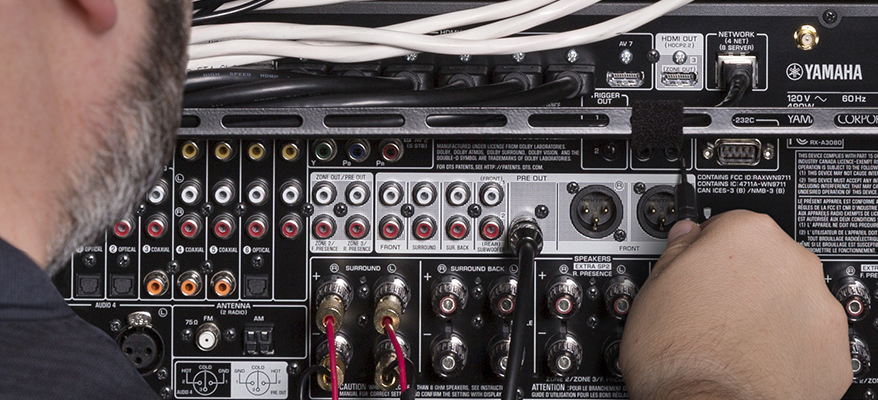Does Your AV Receiver Need an Upgrade?
Don’t get left behind!
Your AV receiver is the heart of your home entertainment system. That means it’s also the gatekeeper. If it’s not up-to-date with the latest technology, you could be missing out on important audio and video advancements and not getting the best experience possible.
Most of us can’t afford to get a new receiver every year. As with cars, it’s important to consider what new features are available, or will be available soon, then decide when it’s worthwhile to buy the latest model. For example, a tailgate that you can open with your foot may not be a priority, but an onboard blind spot warning system might be something you really would like to have.
Let’s take a look at some key features you’ll find in current Yamaha AV receivers so you can decide which might be must-haves for you.
4K, 8K and Ultra HD
Most Yamaha receivers released from 2015 to 2019 support the latest HDMI® standards for 4K Ultra HD, which is defined as 3840 x 2160 pixels. The latest standard, HDMI 2.1, supports 8K, which has an aspect ratio of 7680 x 4320 pixels.
For comparison, high definition (which was previously the highest standard) is 1080 or 1920 x 1080 pixels. More pixels means greater resolution of fine details with greater contrast, which enables you to sit closer to the screen while still enjoying a clear image. Video that originates in 4K can be downscaled by some AV receivers (including many Yamaha models) and still retain high-definition resolution. Blu-ray Discs™ used to be the only place to find 4K movies, but now it’s much more commonly available, with streaming services like Netflix® offering movies and programs in 4K. Most TVs are now also 4K.
HDR (High Dynamic Range)
HDR TVs have much more contrast and many more colors than non-HDR TVs, which gives them more vivid, realistic images. AV receivers that support HDR video formats (such as Dolby® Vision® and Hybrid Log-Gamma [HLG]) give you a full, high-definition experience with exceptionally realistic and natural picture quality. But don’t forget that, in addition to an HDR-capable TV and AV receiver, you need HDR content to enjoy the amazing contrast and lifelike colors. Luckily, like 4K, many streaming services are now offering HDR content.
eARC (enhanced Audio Return Channel)
A feature called ARC (Audio Return Channel) allows audio to be sent from your TV to your AV receiver through the same HDMI cable that carries the video signal from your AV receiver to the TV. Enhanced ARC (eARC) increases bandwidth, which enables signals from high-res audio (like Dolby TrueHD® and DTS-HD Master Audio™) as well as 3D surround sound formats (such as Dolby Atmos® and DTS:X™) to be sent uncompressed, so you can enjoy movie theater-quality experience at home.
Artificial Intelligence
Yamaha receivers were the first to incorporate artificial intelligence with Surround:AI™, a technology that analyzes the DSP parameters for each scene of a movie five times per second — essentially, in real time. By focusing on distinct sound elements (such as dialogue, background music, ambient sounds and sound effects), Surround:AI automatically optimizes the overall surround effect for your home theater, making intimate dialogue-heavy scenes just as engrossing as raging battle scenes.
Whole-Home Audio
No receiver should be an island. If your AV receiver is part of a larger family of devices designed to work together, like Yamaha MusicCast-enabled products, then you’re able to enjoy whole-home audio. Being able to wirelessly share music from a variety of sources to sound bars and speakers in other rooms — even in your backyard — is a music lover’s dream come true.
Voice Control
Chances are you already have a voice assistant in your home, whether it be Alexa, Google Assistant™ or Siri®. But if you want to ask for music, you’re not limited to talking to your smart speaker. Many modern AV receivers can be controlled by voice too — just ask for your favorite music (or turn the power on and off) without having to hunt for the remote control!
So should you replace your old faithful AV receiver that still sounds great, but can’t take advantage of the latest audio, video and smart home technologies? The choice is yours, but if you already have an AV receiver, chances are you value high-quality sound and immersive entertainment … and there’s no question that the latest features can be very tempting!
Check out these related blog articles:
HDMI® 2.1: What It Means for Gear and Gamers
The Perfect Pairing: Yamaha MusicCast and Home Automation
Smart Home Integration — From DIY to CI Guy
Enjoy Music Outdoors with Zone 2
How to Use Alexa with MusicCast
How to Use Actions on Google with Yamaha MusicCast
Click here for more information about Yamaha AV receivers.















